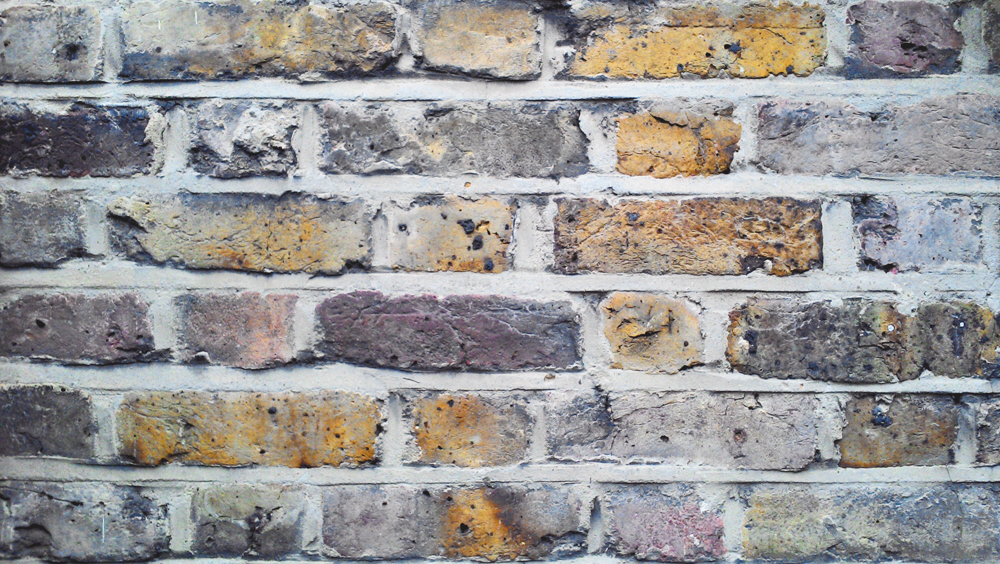Cement mortar
Mortar is applied as a thick paste which sets hard as it cures. It creates a tight seal between bricks and blocks to prevent air and moisture entering into a construction. It can compensate for variations in brick or block size to produce an aesthetically-pleasing and structurally-sound construction. Generally, mortar is intentionally structurally weaker than the blocks or bricks it bonds, creating a sacrificial layer that is more easily repaired than defects would be in the bricks or blocks themselves.
Mortar is composed from a mixture of a fine aggregate (typically sand), a binder and water. The binder is generally either lime or cement. If lime is used, mortar is described as ‘lime mortar’ whereas if cement is used it is referred to as ‘cement mortar’ (a small amount of lime may also be also be used in cement mortars). For more information see: Types of mortar.
Lime mortar tends to bind masonry more ‘gently’ than cement mortar, as it is more flexible and gives earlier adhesion, but it gains strength more slowly. Where less flexible, dense mortars such as cement mortar are used to bind softer masonry, such as soft sandstones, they can cause local stresses leading to the deterioration of the masonry. For more information see: Lime mortar.
Cement mortar was invented by English cement manufacturer Joseph Aspdin in 1794 in order to create a cement that was stronger than lime mortar.
Water and cement set and harden through a chemical reaction known as 'hydration'. The process of hardening is described as 'curing', which requires particular conditions of temperature and humidity.
There are a number of different types of cement. Portland cement is the principal cement used in most masonry mortars. It is manufactured by heating together limestone (or chalk) and clay (or shale) in large rotary kilns. The chemistry of Portland cement largely consists of calcium silicate which reacts with water to form a strong, durable cement paste. For more information see: Cement and Portland cement.
The ratio of cement to sand is typically in the ration of 1:2 to 1:6 depending on what the mortar is being used for, with a higher proportion of sand producing a weaker mortar. Where lime is included, the ratio is express as; cement: lime: sand.
Generally, the sand and cement are first mixed until uniform, and then water is slowly added while mixing until the required consistency is achieved.
Soft sand (building sand) is generally used for bricklaying and pointing using thinner layers of mortar, whereas Sharp sand is used where a thicker layer of mortar is required.
Premixed mortars are available to which water is added.
A range of different colours can be achieved depending on the type of sand used, or by the addition of dyes. A number of admixtures can also be included to accelerate or retard drying, to make the mortar easier to work, to improve waterproofing, to increase cohesion and so on.
[edit] Related articles on Designing Buildings Wiki.
Featured articles and news
RTPI leader to become new CIOB Chief Executive Officer
Dr Victoria Hills MRTPI, FICE to take over after Caroline Gumble’s departure.
Social and affordable housing, a long term plan for delivery
The “Delivering a Decade of Renewal for Social and Affordable Housing” strategy sets out future path.
A change to adoptive architecture
Effects of global weather warming on architectural detailing, material choice and human interaction.
The proposed publicly owned and backed subsidiary of Homes England, to facilitate new homes.
How big is the problem and what can we do to mitigate the effects?
Overheating guidance and tools for building designers
A number of cool guides to help with the heat.
The UK's Modern Industrial Strategy: A 10 year plan
Previous consultation criticism, current key elements and general support with some persisting reservations.
Building Safety Regulator reforms
New roles, new staff and a new fast track service pave the way for a single construction regulator.
Architectural Technologist CPDs and Communications
CIAT CPD… and how you can do it!
Cooling centres and cool spaces
Managing extreme heat in cities by directing the public to places for heat stress relief and water sources.
Winter gardens: A brief history and warm variations
Extending the season with glass in different forms and terms.
Restoring Great Yarmouth's Winter Gardens
Transforming one of the least sustainable constructions imaginable.
Construction Skills Mission Board launch sector drive
Newly formed government and industry collaboration set strategy for recruiting an additional 100,000 construction workers a year.
New Architects Code comes into effect in September 2025
ARB Architects Code of Conduct and Practice available with ongoing consultation regarding guidance.
Welsh Skills Body (Medr) launches ambitious plan
The new skills body brings together funding and regulation of tertiary education and research for the devolved nation.
Paul Gandy FCIOB announced as next CIOB President
Former Tilbury Douglas CEO takes helm.
UK Infrastructure: A 10 Year Strategy. In brief with reactions
With the National Infrastructure and Service Transformation Authority (NISTA).























